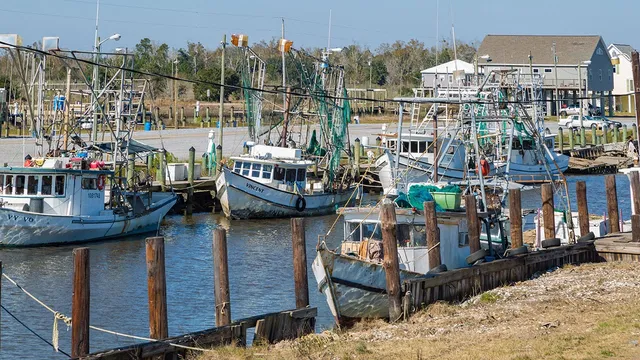
U.S. shrimp industry faces crisis as tariffs bring hopes for revival
2025-04-04 15:10- The U.S. shrimp industry, especially in Alabama, suffers from over 90% of shrimp being imported, forcing local shrimpers to cut prices.
- Shrimpers are advocating for higher tariffs to protect their livelihood while facing significant challenges from unfair trade practices.
- The implementation of tariffs is seen as a crucial step toward potentially revitalizing the dying shrimp industry.
Express your sentiment!
Insights
In recent years, the shrimp industry in the U.S., particularly in Alabama's Bayou La Batre, has confronted a severe crisis due to an overwhelming influx of cheap imports. Shrimp imports now make up over 90% of the shrimp consumed in the country, significantly impacting domestic prices and forcing U.S. shrimpers to reduce their prices in order to remain competitive. As a consequence, many local shrimpers, who rely on this trade for their livelihoods, have voiced their concerns to the Trump administration, urging for the implementation of tariffs to protect their struggling industry. This sentiment has gained momentum, with nearly 200 comments received by the administration indicating the industry’s bleak outlook. U.S. shrimpers argue that many foreign producers adhere to practices that undermine fair competition. They highlighted issues such as significant investments in foreign aquaculture, illegal use of antibiotics, and environmental degradation as challenges that threaten their survival. In December, the International Trade Commission authorized tariffs on shrimp imports from countries like Ecuador, India, Vietnam, and Indonesia for at least five years, yet many in the industry believe the tariffs are insufficient to create any meaningful change. The Southern Shrimp Alliance has positioned the tariffs as a necessary first step to rehabilitate an industry that has been in decline. The hope now is that these tariffs will lead to improved prices for American shrimpers, who have seen their revenues plummet, with a reported 38% drop in revenue recorded from 2022 to 2023, decreasing from $329 million to $202 million despite only a slight decrease in landings. Moving forward, the shrimpers not only call for higher tariffs but are also hopeful about potential growth in shipbuilding in their area that might offer some economic relief. While the shrimping industry appears to have found its voice in Washington, the future remains uncertain, and many local businesses may struggle to sustain their operations amidst these challenges.
Contexts
The impact of shrimp tariffs on the U.S. economy has garnered significant attention, especially given the intricate balance of international trade relationships and domestic market dynamics. Shrimp is a popular seafood product in the United States, and tariffs imposed on imported shrimp can directly influence prices in the domestic market, affect supply chains, and impact consumers' purchasing power. As of 2023, the U.S. shrimp market relies heavily on imports, with most shrimp being imported from countries such as Thailand, Vietnam, and Ecuador. Tariffs, which are taxes levied on imported products, can lead to increased costs for consumers, reducing demand and altering consumption patterns. The price elasticity of demand for shrimp is a critical factor; if consumers are highly sensitive to price changes, significant tariffs could result in reduced sales volumes and potential losses for domestic retailers and restaurants that rely on affordable seafood options. Additionally, the imposition of tariffs on shrimp can have downstream effects on related industries. For example, the seafood processing industry might face higher input costs if shrimp tariffs drive up prices. This may lead to narrower profit margins, potentially resulting in workforce reductions or even business closures if companies cannot adapt to the altered economic landscape. Furthermore, the economic impact is not limited to local businesses; it has wider implications for international trade relationships. Countries affected by these tariffs may retaliate with their own tariffs on U.S. exports, creating a cycle of trade tensions that may hinder overall economic growth. Economic analysis also has to consider the employment effects related to the shrimp industry, which offers jobs both directly in shrimp farming and harvesting and indirectly in processing and distribution sectors. If tariffs significantly disrupt import volumes, there may be job losses or reduced hours for workers in those sectors. Conversely, proponents of shrimp tariffs often argue that such measures could help protect U.S. shrimp producers from foreign competition, potentially boosting domestic production and creating jobs in the long term. However, the transition period can be painful, and any job gains may not happen quickly enough to offset immediate job losses. In conclusion, the economic implications of shrimp tariffs on the U.S. economy are multifaceted and interlinked. On one hand, there are potential benefits for domestic producers; on the other, significant risks for consumer prices, industry relationships, and international trade dynamics are apparent. As policymakers consider the future of trade measures, particularly concerning shrimp tariffs, a careful balance must be struck to safeguard U.S. economic interests while maintaining healthy consumer options and preventing retaliation from trading partners.